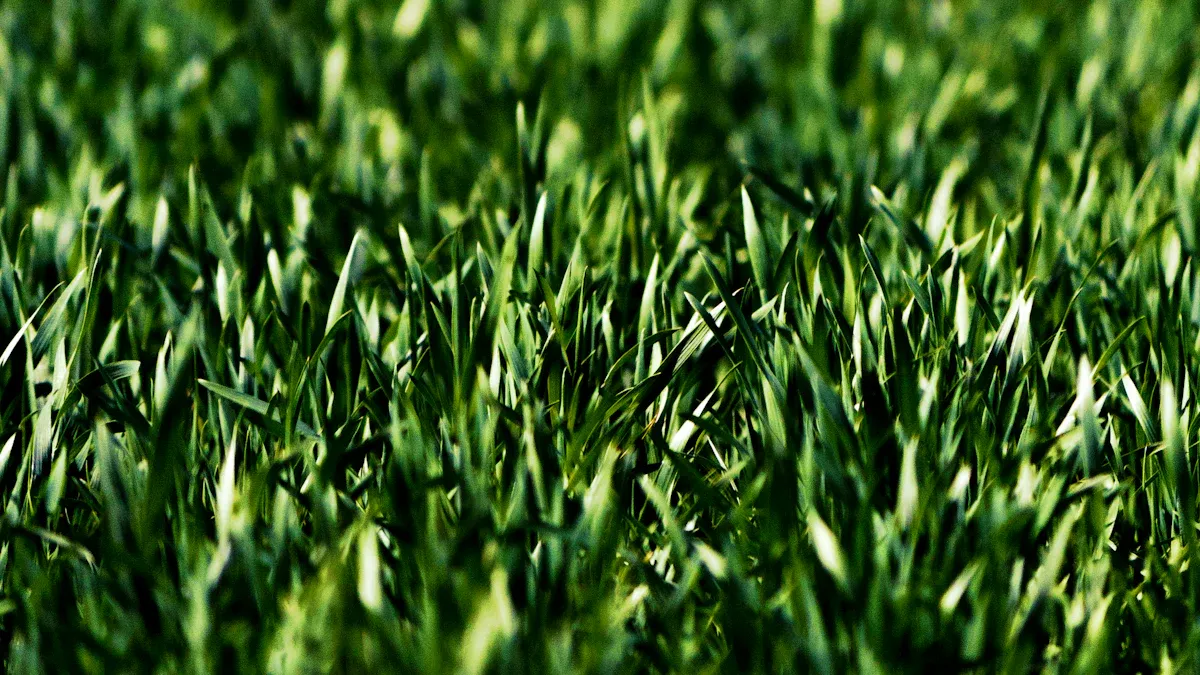
St. Augustine grass has unique characteristics. Its wide leaves demand sharp mower blades for a clean cut. Dull blades shred the grass, creating a ragged appearance and stressing the turfgrass. Proper mowing is crucial for the health, density, and overall quality of your turfgrass. Mowing too low diminishes its ability to recover and encourages weeds. To effectively mow st augustine grass, you must understand optimal height, frequency, and techniques. This consistent mowing approach ensures a resilient, attractive lawn.
Key Takeaways
- Mow St. Augustine grass to a height of 3-4 inches. This protects it from heat and helps it keep water.
- Always follow the “one-third rule.” Never cut off more than one-third of the grass blade’s height at one time.
- Use a mower with sharp blades. Dull blades tear the grass and make it unhealthy.
- Never mow wet grass. It can harm your mower, spread diseases, and make your lawn uneven.
- Change your mowing pattern each time. This helps the grass grow strong and prevents ruts in your lawn.
Optimal St. Augustine Mowing Height

You must understand the correct cutting height for your St. Augustine grass. Mowing too low, especially in full sun, can severely damage or even kill your lawn. This practice stresses the grass and makes it vulnerable.
Seasonal Height Adjustments for St. Augustine Grass
Adjusting your mower’s cutting height throughout the year is essential for a healthy St. Augustine lawn. From January through April, you should set your mower to 2 to 2.5 inches. This helps remove dead material from the previous season and encourages the grass to emerge from dormancy.
As summer approaches, you need to raise your mower’s deck. During the warmer months, a taller grass blade provides more shade to the soil and the grass’s stolons. This helps the grass retain moisture and protects it from intense heat. Many experts agree on higher mowing heights for St. Augustine grass in summer.
| Source | Recommended Mowing Height (inches) |
|---|---|
| The Lawn Forum | 3″ (minimum), 4-4.5″ (ideal) |
| The Lawn Care Nut | 4″+ |
| Texas A&M | 2.5″ to 3″ (3″ to 3.5″ in shade) |
| Neil Sperry | 2″ to 2.5″ |
| University of Florida | 3.5″ to 4″ (varies by cultivar) |
You should keep St. Augustine grass taller than most other warm-season grasses. This is especially true in hot climates with direct sunlight. A minimum height of 3 inches works for a healthy lawn in these conditions. An optimal mowing height of 4 to 4.5 inches is even better. St. Augustine grass spreads through stolons. These are stems that grow along the ground surface. If these stolons do not have enough shade, they can dry out. This leads to yellowed or dead areas in very hot spots. Also, in shady areas, a higher cutting height helps the leaves capture enough light for photosynthesis.
As fall arrives, continue to maintain a lawn height of 3 inches for your St. Augustine grass. Do this until it enters dormancy. When nighttime temperatures drop below 70 °F, you should increase the mowing height by ½ to 1 inch. This adjustment gives the turfgrass more leaf surface. It helps the grass get ready before the first frost. This proper mowing helps your lawn stay strong.
Avoiding Scalping and Stress
Scalping your St. Augustine grass means cutting it too short. This causes significant stress to your lawn. Mowing at heights lower than the recommended 3.5–4 inches increases stress on the lawn. It also stops deep root systems from growing. This can make your lawn more likely to get pest problems.
For example, one person cut their Palmetto St. Augustinegrass too short after it grew tall for nine days. The next morning, the lawn turned yellow. This showed serious damage from the improper cut.
If your lawn is mostly green, you can still scalp, but just know it’ll take a few weeks to recover.
You should always avoid scalping. It weakens your grass and makes it harder for your lawn to recover. Always prioritize the recommended mowing heights to keep your turfgrass healthy and vibrant. This ensures your spring and summer mowing height choices support a strong lawn.
Mowing Frequency and Timing for St. Augustine Grass
You need to understand how often to mow St. Augustine grass. This grass type generally requires less frequent mowing compared to many other lawn grasses. You typically mow it once every one to two weeks. This schedule helps maintain its health and appearance.
Determining Mowing Schedule
Your mowing schedule changes with the seasons. During the summer, St. Augustine grass grows quickly. This is its peak growth period. You will need to mow weekly during these warmer months. A healthy St. Augustine lawn thrives with this regular summer cutting. For example, in northeast Florida, you should mow to a 4-inch height from April to October. This covers the entire peak growing season.
As winter approaches, the grass growth slows down. You can reduce your mowing frequency. During winter, you will likely mow every two to three weeks. Always observe your grass. It tells you when it needs a cut.
A key principle for mowing is the “one-third rule.” This rule states you should never remove more than one-third of the grass blade’s height at one time. If you mow your St. Augustine grass at 3 inches, you should cut it when it reaches 4 to 4.5 inches tall. This prevents stress to the turfgrass.
Some people in South Florida might not strictly follow the one-third rule. This is because St. Augustine grass grows very fast there. However, turf science professors and landscaping professionals in Florida still recommend following it. Deviating from this rule can harm your lawn. Even if some lawns seem to do well without strict adherence, it is a risk.
Here is a guide for St. Augustinegrass based on the one-third rule:
| Grass Type | Mowing Height (inches) | Max Cut Height (inches) |
|---|---|---|
| St. Augustinegrass | 2 to 3 | 3 to 4.5 |
Always follow this rule. It keeps your grass strong and healthy.
Best Time to Mow
The best time to mow your St. Augustine grass is when it is dry. Mowing wet grass can lead to uneven cuts. It can also clog your mower. This can spread diseases.
You should aim to mow in the late morning or late afternoon. The grass has dried from dew by late morning. The intense heat of midday has passed by late afternoon. This timing reduces stress on your grass. It also gives the grass time to recover before the evening. Avoid mowing during the hottest part of the day. This can stress the grass and you.
Mower Equipment and Blade Care for Good Mowing Practices

Choosing the Right Mower
You need the right mower for your St. Augustine grass. A good mower ensures a clean cut. Reel mowers are ideal for this type of grass. They provide precise cuts, like scissors. This promotes healthier growth. Rotary mowers also work well for St. Augustine grass. Make sure their blades are sharp. They can handle thicker areas effectively. Many users recommend Scag mowers for cutting St. Augustine grass. Most zero-turn radius (ZTR) mowers can cut cleanly. They do this in one pass. Always keep your mower blades sharp. Choosing the right mower is part of good mowing practices. This choice impacts the overall quality of your lawn.
Importance of Sharp Blades
Sharp blades are vital for healthy turf. Dull blades tear the grass. This causes stress to your lawn. Stressed lawns use energy to heal. They have less energy to fight pests and diseases. This makes your turfgrass more vulnerable. In extreme cases, the lawn can die. After mowing with dull blades, grass tips look shredded. Sharp blades give smooth, clean edges. Dull blades make grass stalks ragged and brittle. They also make them yellowed. This tearing weakens the lawn. It increases susceptibility to weeds, insects, and disease. Dull blades can even rip grass out by the roots. This leads to bare, patchy areas. Dull blades create a ragged appearance for St. Augustine grass. They cause an unsightly yellow hue. They increase disease susceptibility. Damaged turf results from pulling and ripping. Regular blade maintenance is key for effective mowing practices. This simple step protects your lawn. Your mower performs better with sharp blades.
Pre-Green-Up Dormant Grass Removal
Before your St. Augustine grass greens up, you should remove dormant material. This is an important step for your lawn. Use a rotary mower for this task. Set your mower to 2.5 inches. This low setting helps remove dead leaves from the previous season. This early season mowing prepares your lawn for new growth. It clears out debris that can hinder the emergence of fresh blades. This practice also helps prevent thatch buildup. Your mower effectively cleans the area. This ensures your St. Augustine turf starts the growing season strong. Proper mower use at this stage is crucial for overall lawn health. Make sure your mower is ready for this important task.
Effective Mowing Techniques
You need to use specific techniques to effectively mow St. Augustine grass. These methods ensure your lawn stays healthy and vibrant. Proper mowing protects your turfgrass and promotes strong growth.
The One-Third Rule Application
Always follow the one-third rule when you mow St. Augustine grass. This rule means you never remove more than one-third of the grass blade’s height in a single cutting. For example, if you maintain your grass at 3 inches, you should cut it when it reaches 4 to 4.5 inches. This prevents stress on the turfgrass. It allows the grass to recover quickly. You help your lawn develop a deeper root system when you follow this rule. This makes your lawn more resilient.
Varying Mowing Patterns
You should change your mowing pattern each time you cut your lawn. Do not always mow in the same direction. Varying your pattern offers several benefits:
- It prevents ruts from forming in your lawn.
- It encourages the grass to grow upright.
- It strengthens the grass by allowing it to recuperate.
- It prevents weakening of the ‘runners’ (growing tentacles) of your St. Augustine grass.
This simple change helps distribute the pressure from your mower evenly. It promotes a thicker, more uniform lawn appearance.
Avoiding Wet Grass
Never mow wet grass. Mowing when the grass is wet can cause many problems for your lawn and your mower.
- Damage to the Lawn Mower: Water can enter your mower’s fuel tank, causing engine malfunction. Wet grass clippings clog the blades and vacuum, forcing your mower to work harder. This can lead to engine strain, smoking, and overworking. Electric mowers are especially vulnerable due to lower torque. Moisture also causes rust and corrosion on metal parts, leading to costly repairs or replacement for your mower.
- Safety Hazards: Wet grass creates slippery conditions. This increases your risk of falls and injuries, especially on sloped areas. If you use an electric mower, operating it in wet conditions poses a risk of electric shock. Water and electricity are a dangerous combination.
- Soil Compaction and Rutting: Mowing over wet soil compacts it. This suffocates grass roots by reducing oxygen. You can end up with thin, patchy grass or ruts in your lawn. Wet grass clippings also clump together. They block sunlight, water, and airflow. This contributes to patchy and unhealthy lawn areas.
- Poor Mulching and Bagging Performance: Wet grass clippings do not distribute evenly. This reduces their effectiveness as a natural fertilizer. Bagging also becomes less efficient.
One personal account describes attempting to mow grass covered in morning dew, which quickly led to the mower blades becoming clogged with damp grass. This caused additional strain on the engine and slowed down the entire mowing process. The experience highlighted that waiting for the lawn to dry, even for an hour or two, significantly reduces the effort and time required for mowing.
In 2010, over 250,000 people received treatment for injuries related to lawn mowers, as reported by the U.S. Consumer Product Safety Commission. This highlights general safety risks, which increase when you mow wet grass. Always wait for your lawn to dry completely before you start your mower.
Post-Mowing Lawn Care
After you finish mowing, proper care helps your St. Augustine grass stay healthy. These practices ensure your lawn recovers well and thrives. Good post-mowing practices contribute to the overall quality of your turfgrass.
Handling Grass Clippings
You have options for handling grass clippings. If you manage your lawn correctly, you can leave clippings on the lawn. They decompose naturally. These clippings supply many nutrients your lawn needs. Mow when leaf blades are dry for better sifting. Ensure your mower blades are sharp. Mow frequently enough so clippings are not too large. Always mow at the recommended height. For example, if you mow St. Augustine grass at 2 inches, you should cut it when it reaches 3 inches. This follows the one-third rule.
If you need to remove clippings, collect them in a bin or compost pile. Mix them well with other organic material. Wear gloves and a mask when you handle clippings. This avoids breathing in dust and mold spores. Store any excess clippings in a covered container. This prevents rain from washing away nutrients. If you use grass clippings as mulch, do not apply too much at once. Avoid using clippings from chemically treated lawns. Do not store clippings in plastic bags. They can ferment and produce foul odors.
Post-Mow Watering Practices
Water your lawn after mowing if it needs moisture. Do not overwater. Deep, infrequent watering encourages strong root growth. This makes your grass more resilient. Check the soil moisture before you water. Your lawn needs about one inch of water per week. This includes rainfall.
Monitoring Lawn Health
Regularly check your lawn after mowing. Look for signs of stress or disease. Yellowing of the grass blade can indicate a problem. Thinning of the turf, resulting in irregular brown patches, is another sign. Rotting of the root makes the grass easy to pull out. Improper mowing can cause issues like Take-all root rot (TARR) in St. Augustine grass. Early detection helps you address problems quickly. Consistent maintenance helps prevent these issues.
Consistently applying these effective strategies ensures a healthier, more vibrant, and disease-resistant St. Augustine lawn. Make these 2025 best practices a fundamental part of your lawn care routine for improved quality. You will achieve a beautiful lawn when you mow st augustine grass with proper mowing techniques. Your diligent efforts will result in exceptional lawn quality.
FAQ
What is the best mowing height for St. Augustine grass?
You should mow St. Augustine grass to 3-4 inches during summer. This height protects the grass from heat and helps retain moisture. In winter, you can lower the height to 2-2.5 inches. This removes dead material and encourages new growth.
What is the “one-third rule” when mowing?
The “one-third rule” means you never remove more than one-third of the grass blade’s height in a single cut. For example, if you want your grass at 3 inches, cut it when it reaches 4 to 4.5 inches. This rule prevents stress on your lawn.
What happens if you mow St. Augustine grass when it is wet?
Mowing wet grass causes many problems. It clogs your mower and leads to uneven cuts. Wet grass can spread diseases and compact your soil. It also creates slippery conditions, which are unsafe. Always wait for your lawn to dry completely.
What type of mower works best for St. Augustine grass?
Rotary mowers are effective for St. Augustine grass. Reel mowers also provide very precise cuts, which promotes healthier growth. Regardless of the type, always use a mower with sharp blades. Sharp blades ensure a clean cut for your lawn.

